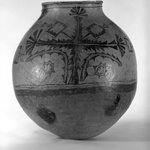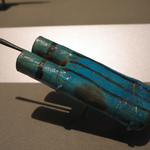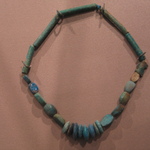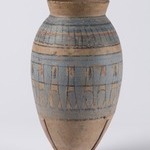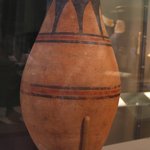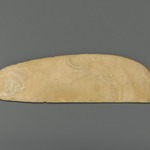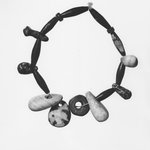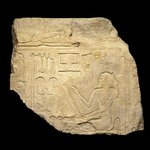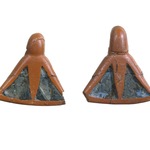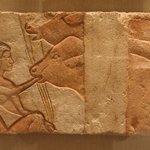Can you tell me anything about the odd figures on this bowl?

A lot of Early Dynastic art was painted on pottery. These figures are typical of that type of art. Here they are seen on a boat. The largest figure is the most important. She may represent a goddess or priestess. Smaller male figures stand on either side and appear to be attending to her.
There is a case in the central Egyptian gallery where you can see three dimensional figurines in similar poses with their arms raised.
How did the geography affect the development of the Egyptian society?
The Nile River is the most important part of the landscape of ancient and modern Egypt. About ten thousand years ago, hunter-gatherers moved from the disappearing grasslands (where the Sahara Desert is located today) into the fertile Nile valley for survival. This population boom led to the need for an organized society which evolved into what we know as ancient Egypt. It took a great deal of continued organization to make sure that the narrow strip of fertile land in the desert that flooded annually could support a large population.
The river and the careful delineation of land into the floodplain where farming happened, the low desert where people lived, and the high desert where people were buried featured in their art and belief system.
The river and its marshy edges were understood as the source of all life. The river was, and still is, a key mode of transportation.
Tell me more.

In the ancient art of many regions, the largest figure is the most important. The woman here, with her arms raised in dance or celebration, may represent a goddess or priestess. Smaller male figures stand on either side and appear to be attending to her. Decorated pottery like this helps scholars interpret sculptures from the same time period like the ones in a nearby case.
What materials and tools were used to make this?

This is made from clay and natural pigments, taken from colored earth.
The clay was formed by hand, not on a wheel. Based on the shape of this particular vessel a coil technique was likely used.
What was the purpose of this?

A jar of this shape and size would have been used for storage, like for liquids (water, wine, oil, et cetera).
The thick lip at the top meant that you could cover the opening with a piece of cloth or skin and wrap a rope to keep it closed.
We know that this jar comes from a tomb, so we might also guess that the decoration served some religious purpose.
What's going on on this jar? I think I see trees on the side, and the people look like they're on a boat.

Yes, they are on a boat! Boats were very important in ancient Egypt.
The Nile River was the source of life for Egyptians, who hunted birds, animals and fish that lived in the river.
Even the clay that the pot was made from came from the river beds of the NIle!
I see people in the middle and one has their arms in a heart shape.
Yes! The heart shaped figure in the center is actually a woman with her hands raised up in the air. She is bigger than the two men that flank her, and is possibly a goddess.
Nearby you can see an older terracotta statue of a woman in the same position, for context!
Is a string supposed to go through the holes?

You're right! Rope was threaded through the holes near the top. The rope could hold the lid on or hang the jar up!
Really? Wow!











